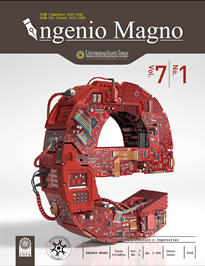Análise comparativa das metodologias de arquitetura da informação aplicada a contextos empresariais
##plugins.themes.bootstrap3.article.main##
Resumo
Downloads
##plugins.themes.bootstrap3.article.details##
DECLARACIÓN DE ORIGINALIDAD DE ARTÍCULO PRESENTADO
Por medio del presente documento, certifico(amos) que el artículo que se presenta para posible publicación en la revista institucional INGENIO MAGNO del Centro de Investigaciones de Ingeniería Alberto Magno CIIAM de la Universidad Santo Tomás, seccional Tunja, es de mi (nuestra) entera autoría, siendo su contenido producto de mi (nuestra) directa contribución intelectual y aporte al conocimiento.
Todos los datos y referencias a publicaciones hechas están debidamente identificados con su respectiva nota bibliográfica y en las citas que se destacan como tal. De requerir alguna clase de ajuste o corrección, comunicaré(emos) de tal procedimiento con antelación a los responsables de la revista.
Por lo anteriormente expresado, declaro(amos) que el material presentado en su totalidad se encuentra conforme a la legislación aplicable en materia de propiedad intelectual e industrial de ser el caso, y por lo tanto, me(nos) hago (hacemos) absolutamente responsable(s) de cualquier reclamación relacionada a esta.
En caso que el artículo presentado sea publicado, manifiesto(amos) que cedo(emos) plenamente a la Universidad Santo Tomás, seccional Tunja, los derechos de reproducción del mismo.
Referências
Baeza-Yates, R., Loaiza, C. R. y Martín, J. V. (2004). Arquitectura de la información y usabilidad en la web. El Profesional de la información, 13(3), 168-178.
Buckl, S., Ernst, A. M., Matthes, F., Ramacher, R. y Schweda, C. M. (2009). Using enterprise architecture management patterns to complement TOGAF. Enterprise Distributed Object Computing Conference, 2009. Doi: 10.1109/EDOC.2009.30
Chaczko, Z., Kohli, A. S., Klempous, R. y Nikodem, J. (2010). Middleware integration model for smart hospital system using the open group architecture framework (TOGAF). 14th International Conference on Intelligent Engineering Systems (INES), 2010 (pp. 215-220). Doi: 10.1109/INES.2010.5483846
De Pablos, C. y Montero, A. (2010). Relación de la arquitectura de la tecnología de información con la estructura organizativa en el sector asegurador. Dirección y Organización, 22, 122-130.
Engelsman, W., Jonkers, H. y Quartel, D. (2011). ArchiMate® extension for modeling and managing motivation, principles, and requirements in TOGAF®. Recuperado de http://pubs.opengroup.org/architecture/ archimate2-doc/chap10.html.
Epstein, P. (2012). Weeds bring desease to the east African watarways. Lancet, 351(9102).
Esmaeil-Zadeh, M., Millar, G. y Lewis, E. (2012). Mapping the Enterprise Architecture Principles in TOGAF to the Cybernetic Concepts: An Exploratory Study. Recuperado de https://www.computer.org/csdl/ proceedings/hicss/2012/4525/00/4525e270.pdf
Fernández Hernández, A. (2009). Arquitectura de información de los portales intranets: un componente esencial de la gestión de información en las universidades. Acimed, 19(4).
Gerber, A., Kotzé, P. y Van der Merwe, A. (2010). Towards the formalisation of the TOGAF Content Metamodel using ontologies. Recuperado de https:// goo.gl/Nvz1HU
Harrison, R. (2013). TOGAF® 9 Foundation Study Guide. Zaltbommel: Van Haren.
Jonkers, H., Proper, E. y Turner, M. (2009). TOGAF 9 and ArchiMate 1.0. San Francisco: The Open Group.
Jonkers, H., Van den Berg, H., Iacob, M. E., y Quartel, D. (2010). ArchiMate® Extension for Modeling the TOGAF™ Implementation and Migration Phases. White Paper. San Francisco: The Open Group.
Josey, A. (2011). TOGAF® Version 9.1 A Pocket Guide. Zaltbommel: Van Haren.
Lankhorst, M. y Van Drunen, H. (2007). Enterprise architecture development and modelling. Combining TOGAF and ArchiMate. Recuperado de http://goo.gl/ IphJ4l
Laudon, K. C. y Laudon, J. P. (2004). Sistemas de información gerencial: administración de la empresa digital. Ciudad de México: Pearson.
Maya, E. (2010). Arquitectura empresarial: un nuevo reto para las empresas de hoy. Recuperado de http://www. academia.edu/15157112/arquitectura_empresarial_ un_nuevo
Mueller, T., Schuldt, D., Sewald, B., Morisse, M. y Petrikina, J. (2013). Towards inter-organizational enterprise architecture management-applicability of TOGAF 9.1 for network organizations. Recuperado de http://aisel.aisnet.org/amcis2013/GlobalIssues/ GeneralPresentations/1/
Pérez-Montoro, M. (2010). Arquitectura de la información en entornos web. El profesional de la Información, 19(4), 333-338.
Raynard, B. (2008). TOGAF The Open Group Architecture framework 100 success secrets-100 most asked questions: the missing TOGAF guide on how to achieve and then sustain superior enterprise architecture execution. San Francisco: Emereo.
Rodríguez, L. V. D. (2013). Gestión del conocimiento y tecnología de información y comunicaciones. Revista EAN, 58, 41-60.
Serna, M. D. A., Salazar, J. E. L. y Cortés, J. A. Z. (2010). Arquitectura empresarial, una visión general. Revista Ingenierías Universidad de Medellín, 9(16), 101-111.
Sessions, R. (2007). A comparison of the top four enterprise architecture methodologies. Recuperado de https://msdn.microsoft.com/en us/library/bb466232.aspx
Vargas, A., Boza, A. y Cuenca, L. (2011). Lograr la alineación estratégica de negocio y las tecnologías de la información a través de Arquitecturas Empresariales: revisión de la Literatura. V International Conference on Industrial Engineering and Industrial Management (pp. 1061-1070). Recuperado de http://adingor.es/congresos/web/uploads/cio/cio2011/sistemas_de_ informacion/1061-1070.pdf
Vicente, M., Gama, N. y Da Silva, M. M. (2013). Using archiMate and TOGAF to understand the enterprise architecture and ITIL relationship. En Advanced information systems engineering workshops (pp. 134145). Berlín: Springer.
Zachman, J. (2002). The Zachman framework for enterprise architecture. Recuperado de http://www.businessrulesgroup.org/BRWG_RFI/
ZachmanBookRFIextract.pdf
Zachman, J. A. (1987). A framework for information systems architecture. IBM Systems Journal, 26(3), 276-292.
Zachman, J. A. (1999). A framework for information systems architecture. IBM Systems Journal, 38(2-3), 454-470.
Zachman, J. P. (2009). The Zachman framework evolution. Recuperado de https://www.zachman.com/eaarticles-reference/54-the-zachman-framework-evolution
Zadeh, M. E., Millar, G. y Lewis, E. (2012,). Mapping the enterprise architecture principles in TOGAF to the cybernetic concepts: an exploratory study. 45th Hawaii International Conference on System Science (HICSS) (pp. 4270-4276). Doi: 10.1109/HICSS.2012.422

